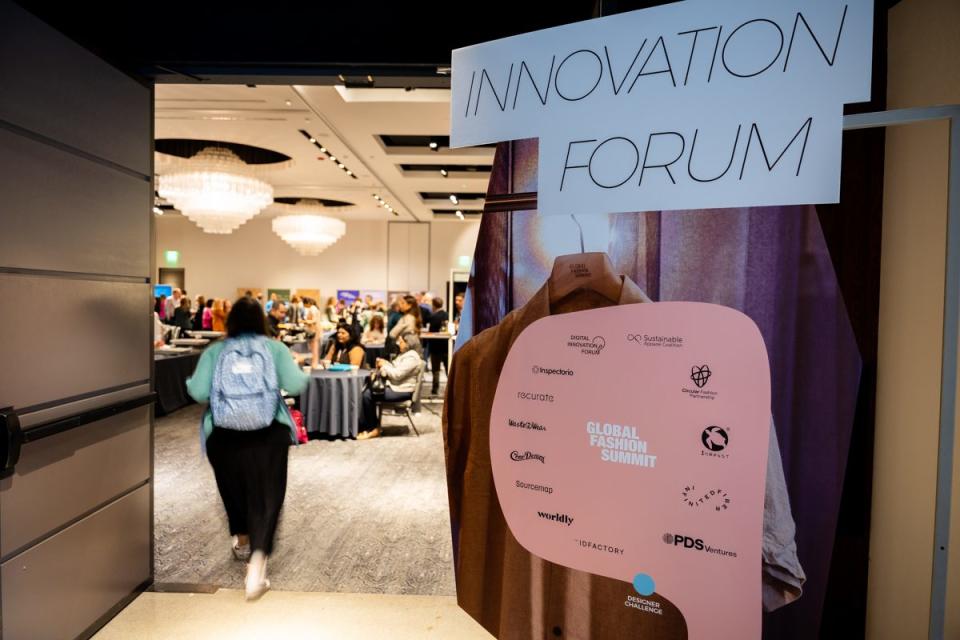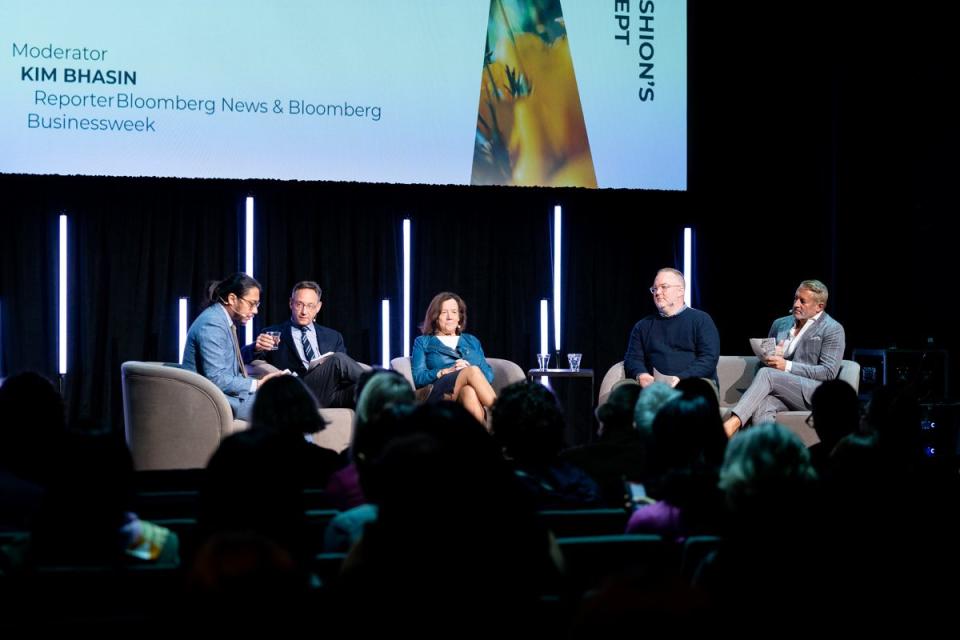All the News From SAC Annual Meeting, Global Fashion Summit’s Boston Edition

For the first time, industry collaborators the Sustainable Apparel Coalition and Global Fashion Agenda cohosted events in Boston, drawing on global leadership perspectives in sustainability.
The consecutive summits were held last week at the Revere Hotel in Boston Common and brought together hundreds of attendees. Topics spanned technology upgrades, new supplier solutions, decarbonization programs, circularity reports and textile policy and more. Speakers hailed from brands including Nike, Target, Tapestry, H&M and Levi’s, as well as the European Commission, non-governmental organizations, academia and innovators.
More from WWD
Indicative of many sustainability-billed events, time was of the essence.
Manufacturer Milestones
The Sustainable Apparel Coalition, in collaboration with Target and Nike, launched a manufacturer decarbonization program at its event themed “Evolution for Impact.”
Dubbed the “Manufacturer Climate Action Program,” the MCAP will be a new SAC member requirement for manufacturers to reach a minimum 45 percent reduction of greenhouse gas emissions by 2030. Open now to Dec. 31, the program is designed to help accelerate decarbonization pathways so the industry can tackle the drastic reductions needed. MCAP evolved from Target’s Supplier Engagement Program and the Supplier Climate Action Program, codeveloped by Nike alongside suppliers and the World Resource Institute.
On the news, the SAC’s director of collective action programs, Joyce Tsoi, said MCAP represents a “key initiative” to unite manufacturers’ decarbonization at scale as part of the SAC’s “Evolution for Impact” strategy. “By partnering with industry leaders and offering scalable solutions, we can empower our industry to confront emission reductions and instigate the change we need to support low-carbon transition.”
The program is designed to support manufacturers in setting and keeping their science-based targets. Without consistency in transparency, tools and guidance, suppliers are often left filling out duplicate audits on their own without clear pathways for success. Financial constraints are also burdensome.
The MCAP hopes to change that. There are four key elements to MCAP: setting science-based targets (Scope 1 and 2), evaluating climate risk, developing a decarbonization plan and disclosing progress annually. Third-party data partners are already signed on to assist the reporting efforts. While the cost is $7,600 per facility, the SAC said it will sponsor the costs for the first 10 manufacturers to come aboard. The goal is to sign on 30 to 40 suppliers to start. Trainings are to follow suit at the SAC’s manufacturer forum this December in Bangalore, India. As for next steps, the SAC’s annual meeting in Munich next year will detail additional updates.

Industry Benchmarking
From the SAC annual meeting, leveraging data insights was a core focus for evolving industry commitments.
One supply chain tool that will see updates in November is the Higg Facility Environmental Module. The tool will measure 70-plus data points including information related to site permits, energy, water, emissions, waste and chemical management.
Progress is gradual but improving. Per a supplier session on the tool during the SAC annual meeting, the percentage of players meeting Higg FEM foundational requirements was 19 percent in 2022, versus 15 percent in 2021. Though it is a marked improvement, the hope is that suppliers see the value in unified supplier codes of conduct and brands incentivize the need — and quickly.
While “preferred fibers” are already commonplace talk in textiles, industry leaders are discussing the benefits of “preferential allocation of volume” to low-carbon suppliers. This is essentially giving the big jobs to the most sustainable suppliers. According to a recent analysis of Higg FEM data by carbon management company Reset Carbon, the top 1,500 facilities contribute to around 79 percent of total emissions or some 82.8 million tons of carbon dioxide equivalents. In the best case scenario, the industry can see an estimated 10 to 25 percent carbon reduction by shifting sourcing.
Labor’s On-ground Influence
Throughout the two-day programming, ambition and real-time evolution were emphasized as being key to a thriving and equitable industry. Labor advocates called for an on-the-ground approach to yielding change.
Using the tragedy of the 2022 Pakistan floods as a backdrop, Better Cotton said it is staging a cash-to-farmers incentive timeline to initiate field-level impact at GFS: Boston Edition. Program details are still in the works. As with many labor advocates, the Fair Wear Foundation is advocating for responsible purchasing practices and common standards (like the Organization for Economic Cooperation and Development, or OECD, and Corporate Sustainability Due Diligence Directive, or CSDDD) as a stand-in to siloed brand corporate codes of conduct.
Perhaps one refreshing takeaway from these conversations was admittance that brand audits simply don’t work in practice, which is why industry organizations are leaning into collective programs. Community solutions could be the antidote, which a recent report on climate adaptation from Cornell University’s Global Labor Institute and Schroders explored in depth.
“One very important piece of this is the recognition that community solutions do exist,” Ashia Sheikh Dearwester, chief strategy and partnerships officer at Nest, said in a conversation on the report at GFS. “It’s important to think about what we can do today, right now, and having an acknowledgement that these individuals on the ground are in survival mode. They have lived experience of these climate events. They also know intimately the environment they are in, and so they have ideas and solutions they are developing just purely out of survival. So, it’s important that that’s recognized by brands and retailers. A key role that brands and retailers can take in supporting these community solutions is really focused on collaboration.…This is a shared ownership of the problem.”

Partnerships Abound
Partnership was one word unabashedly thrown forward by many participants and, rightly so, given apparel’s cross-cutting value chain.
BBC Storyworks and GFA launched “Fashion Redressed,” which is a media campaign meant to highlight diverse makers in fashion, among them indigenous brands like Thunder Voice Hat. GFA also had successive news announcements like its Fashion CEO Agenda 2023 guiding decision-making, latest designer challenge and its novel “Policy Matrix,” meant to signal a changing legislative landscape on par with its event theme of “Ambition for Action.”
Reseller Trove and technology firm Worldly colaunched a report titled “Where Are Circular Models Effective Sustainability Strategies for Fashion Brands?” The report examined the decoupling of new apparel production from used channels for pushing progress. In one advantageous scenario, resale and supply chain advancements led to the most significant decarbonization acceleration. The report also quantified emissions for five apparel archetypes, among them premium apparel, outdoor, midtier apparel, athleisure and fast fashion. Joining the conversation was Paul Dillinger, vice president of global product innovation at Levi’s, who argued in support that the denim brand’s mission is to create “great future vintage” or product uniquely suited for resale.
ESG Cross-Examination

Policy was at the top of the billfold. Javier Sancho, head of global issues and innovation at the European Union Delegation to the U.S., said the green transition is “imperative.”
“Consumers must change the way they consume. Producers must change the way they produce, and policymakers have to create the political will and [framework]. This is a global issue,” he said in an opening address at GFS.
Brands need a government affairs person, said Chelsea Murtha, director of sustainability at the American Apparel and Footwear Association, or AAFA, in a separate, much anticipated policy conversation at the GFS event. She made the case for brands engaging more directly in regulatory efforts. Fashion players from Nike, H&M to ThredUp have allocated resources to these formative hires.
In another ESG conversation at the GFS event, Ken Pucker, professor of ESG practice at Tufts University, said — quite plainly — that voluntary corporate solutions don’t work. He poked at the heart of the matter or what he referred to as the “futility of ‘must.'”
“If you read through any consulting report about the industry, or NGO report, or a lot of journalist reports, you’ll see three words manifest over and over: must, need and should. I’ll give you two examples from what I pulled from yeserday,” he said, while referencing a notecard to quote two examples. “Any overhaul of the supply chain must create an environment in which people and the planet can thrive….Fashion needs to balance global thinking and hyperlocal solutions so change is culturally informed and based on the alternative material [changes] and solutions available.”
He turned back to the audience. “I’ll tell you what, at least public, and private fashion retail companies must do: They must increase their profits, and they must grow. The things that we’re saying they must do are based on the current rules and the systems they mustn’t do. So unless we change the rules, incentives or system structure, I don’t believe we’ll see different behaviors.”
Best of WWD

